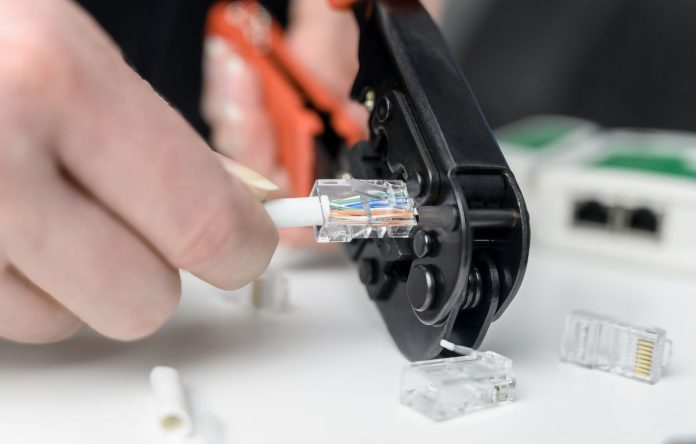Since its inception in 1973, Power over Ethernet (PoE) has continued to revolutionize the way devices are powered and connected. While traditional PoE typically utilizes two pairs of wires in an Ethernet cable, the advent of 4-pair PoE brings forth even greater capabilities and opportunities. What is unique about 4-Pair and why the added wiring “real estate” delivers significant benefit is the subject of this article.
What Is the IEEE 802.3bt Standard?
The IEEE 802.3bt standard, also known as 4-Pair Power over Ethernet (4PPoE), represents a significant advancement in Power over Ethernet (PoE) technology. The Institute of Electrical and Electronics Engineers (IEEE) built upon IEEE 802.3af and IEEE 802.3at to safely deliver more power. 4-Pair enables even greater power delivery capabilities to support a more sophisticated range of devices.
What sets 802.3bt apart is its utilization of all four pairs of wires within an Ethernet cable for power delivery, as opposed to the two pairs used in previous PoE standards.
The IEEE 802.3bt standard outlines two types of Power over Ethernet:
- Type 3 (PoE++) — capable of delivering up to 60 watts of power
- Type 4 (UPoE) — can provide up to 100 watts
These classifications delineate the maximum power levels that can be transmitted over Ethernet cables to power devices, each offering unique advantages and applications. These devices, include pan-tilt-zoom (PTZ) cameras, access points, LED lighting systems, and more.
What Is 4-Pair PoE (4PPoE)?
Unlike traditional PoE implementations that utilize only two pairs of wires within an Ethernet cable for power transmission, 4PPoE leverages all four pairs of wires, effectively doubling the power delivery capacity.
What Are the Business Benefits of 4-Pair PoE?
By utilizing all four pairs of wires, 4PPoE offers several key advantages:
- Increased Power Capacity: With the ability to deliver up to 100 watts of power per device, 4PPoE significantly expands the range of devices that can be powered over Ethernet cables.
- Support for High-Power Devices: This enhanced power capacity makes it suitable for a wide array of applications, including high-performance wireless access points, IP cameras, LED lighting systems, PTZ cameras, LED lighting systems, and display screens, without the need for additional power sources.
- Extended Reach: By leveraging all four pairs of wires, 4PPoE mitigates voltage drops and power losses over longer distances, allowing for reliable power delivery even in large facilities or outdoor deployments. Combining with a PoE extender eliminates the need for additional power sources, simplifying infrastructure deployment.
- Enhanced Reliability: With redundancy built into the power delivery system, 4PPoE offers enhanced reliability compared to traditional PoE implementations. This reduces the risk of power interruptions and ensures consistent power delivery to connected devices, minimizing downtime and optimizing operational efficiency.
- Future-Proofing: As the demand for power-hungry devices and emerging technologies continues to grow, 4PPoE provides a future-proofing solution by offering ample power capacity to support evolving requirements. 4PPoE infrastructure accommodates a full range of power requirements without the need for extensive rewiring or infrastructure upgrades.
By leveraging these higher-power PoE capabilities, organizations have more freedom to support critical infrastructure as they design future networks.
How Is Type 4 Power Different from 4 Pair?
4 Pair indicates the number of copper cable wires used in the IEEE 802.3bt standard. Type 4, on the other hand, indicates 90W power levels supported by 4-pair Ethernet. They represent different aspects of PoE infrastructure.
What Type of Cable Is Required for IEEE 802.3bt?
The IEEE 802.3bt standard specifies that Cat5e, Cat6, or Cat6A Ethernet cables can be used for 4PPoE installations. These cables can handle the increased power levels needed for these more advanced applications. Other considerations include cable length, environmental conditions, and compatibility with networking equipment.
What Applications Does 4-Pair PoE Technology Make Available?
4-Pair Power over Ethernet (PoE) technology opens up a wide range of applications across various industries, enabling the efficient power delivery and connectivity of diverse devices. These might include LED lighting systems, sensors, automated window shades and building control systems.
High-Performance Wireless Access Points (WAPs)
4-Pair PoE technology is ideal for powering high-performance wireless access points (WAPs) in enterprise networks, public Wi-Fi hotspots, and large-scale deployments. These WAPs often require substantial power to support advanced features such as multiple-input and multiple-output (MIMO) technology, beamforming, and high-speed wireless connectivity standards like Wi-Fi 6 (802.11ax).
Pan-Tilt-Zoom (PTZ) Cameras for Surveillance Systems
Surveillance systems rely on PTZ cameras to provide flexible monitoring and surveillance capabilities in various environments, including retail stores, parking lots, and industrial facilities. PTZ cameras require significant power to support motorized movements, optical zoom functionality, and high-definition video streaming. 4-Pair PoE technology enables flexible camera placement without the limits of power outlet proximity. Without the hassle of power outlet placement, securing remote campus areas becomes more cost-efficient.
High-Brightness LED Lighting System
LED lighting systems are increasingly popular for their energy efficiency, longevity, and controllability. High-brightness LED fixtures used in commercial, industrial, and outdoor lighting applications require substantial power to deliver bright illumination levels while maintaining energy efficiency. 4-Pair PoE technology provides a convenient and cost-effective solution for powering high-brightness LED lighting systems over Ethernet cables. By leveraging 4-Pair PoE, businesses can deploy intelligent lighting solutions that offer remote control, dimming capabilities, and energy-saving features without the need for complex wiring or dedicated power circuits.
In Closing
The IEEE 802.3bt standard and 4-pair PoE technology represent significant advancements in networking infrastructure, offering businesses a more efficient, flexible, and cost-effective solution for powering and connecting devices. By embracing these innovations, businesses can streamline their operations, enhance productivity, and unlock new possibilities in the digital age. As the demand for connected devices continues to grow, 4-pair PoE stands poised to play a crucial role in shaping the future of networking and connectivity.


